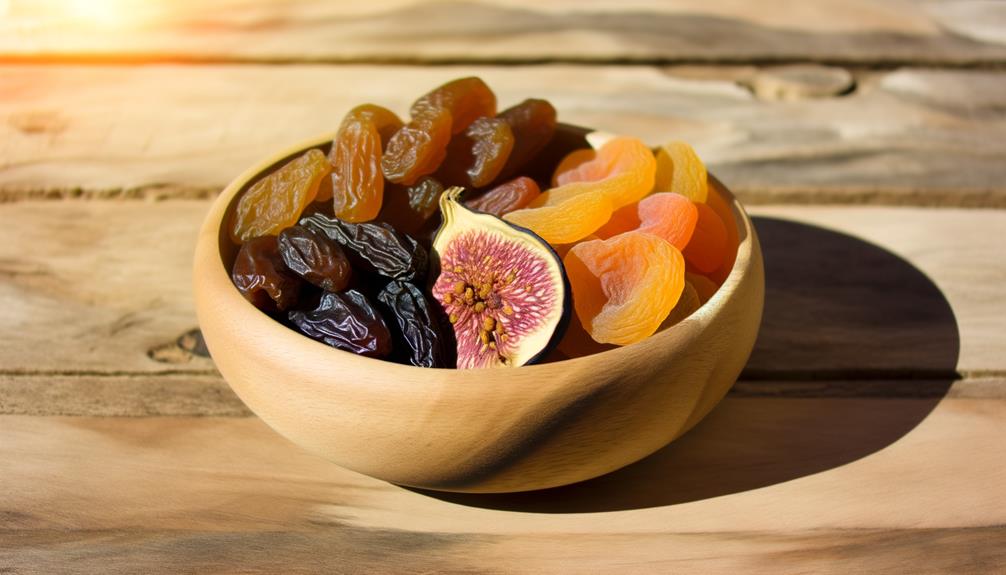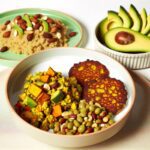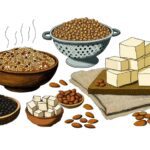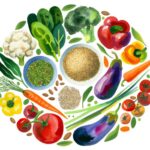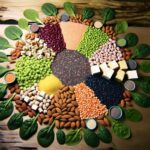In the days of yore, when iceboxes were the norm and the internet was the stuff of science fiction, people across cultures mastered the art of drying fruits to preserve their bounty. You’ve probably enjoyed dried fruits in one form or another, whether it’s the sweet tang of apricots in your morning oats or the chewy satisfaction of raisins in your trail mix. These little gems are not just tasty; they’re packed with nutrients, offering a symphony of vitamins, minerals, and fibers that contribute to a healthier you. But beyond their health benefits, dried fruits carry stories of tradition, innovation, and culinary versatility. As you explore the myriad ways these dehydrated delights can enhance your plant-based journey, you’ll find there’s much more to them than meets the eye. Let’s embark on this exploration together, discovering the ancient roots and modern twists of drying fruits, and uncover why these snacks are more than just convenient — they’re a gateway to a richer, more flavorful world.
Key Takeaways
- Drying fruits has a long history and was one of the earliest forms of food preservation.
- Dried fruits offer unique flavors and textures, making them versatile in culinary creations.
- Dried fruits are packed with nutrients, including fiber, antioxidants, and potassium, which promote overall well-being.
- Understanding the glycemic index of dried fruits is important for managing blood sugar levels, and they can be part of a healthy diet.
History of Dried Fruits
Drying fruits, an ancient practice dating back to 1500 BC, revolutionized how we preserve and enjoy the natural sweetness of harvests long past their picking. This method, originating as the earliest form of food preservation, enabled early civilizations in the Middle East to cultivate and savor dried fruits for their stability and concentrated flavors. Imagine the vibrant markets of ancient Mesopotamia, where tablets bearing the oldest known written recipes celebrated these dehydrated delights.
The date palm, flourishing in the Fertile Crescent, became one of the first trees cultivated for its fruit, signifying abundance and sustenance. As grape cultivation and raisin production thrived under the nurturing hands of the Phoenicians and Egyptians, the practice of drying fruits spread across northern Africa. These sun-kissed treats, once the privilege of ancient Romans who consumed raisins in large quantities, have transcended time.
Centuries later, the tradition continues, with California’s San Joaquin Valley at the forefront, nurturing an array of dried fruits that grace our tables. This practice, steeped in history, connects us to generations past and invites us to serve others by sharing the enduring, plant-based bounty of nature’s sweetness.
Preparation Techniques
Before diving into the myriad ways fruits can be dried, it’s essential to understand that whether you’re dealing with whole fruits, slices, or purees, each method offers unique benefits and textures perfect for various culinary creations. Drying fruits isn’t just about preserving them; it’s a way to concentrate their flavors, enhance their nutritional value, and make them versatile for a myriad of dishes. Whether you’re looking to add a sweet touch to your baking, a flavorful twist to your sauces, or a nutritious boost to your snacks, dried fruits provide that and more.
When you choose to dry fruits, you’re embracing a method that retains the fruits’ essential vitamins and minerals, making them a powerhouse of nutrition. Imagine enriching your confectioneries, sweets, or savory dishes with the natural sweetness and health benefits that dried fruits offer. They’re not just ingredients; they’re a step towards a more nourishing, flavorful, and vibrant culinary experience. Plus, by incorporating dried fruits into your recipes, you’re contributing to a healthier, more sustainable food system that values the power of plant-based ingredients. So, let’s celebrate the diversity and richness that dried fruits bring to our tables and hearts.
Health Benefits
After exploring how dried fruits can elevate your culinary creations, it’s worth noting the significant health benefits they offer to your diet. Dried fruits are not just tasty additions to your meals; they’re packed with nutrients that can enhance your well-being. When you incorporate them into your diet, you’re not only indulging in their rich, sweet flavors but also contributing to a healthier lifestyle that benefits not just you but also those around you by setting a positive example.
Here are four key benefits you’ll enjoy:
- Enhanced Digestive Health: Dried fruits, being high in dietary fiber, help in regulating your digestive system, preventing constipation, and promoting gut health.
- Rich in Antioxidants: They’re loaded with antioxidants, which combat free radicals in your body, reducing oxidative stress and lowering the risk of chronic diseases.
- Improved Energy Levels: With natural sugars and nutrients, dried fruits provide a quick energy boost, making them an ideal snack for those leading active lifestyles or needing a midday pick-me-up.
- Heart Health: The potassium found in dried fruits supports heart health by helping to maintain normal blood pressure levels and preventing heart disease.
Incorporating dried fruits into your diet isn’t just a treat for your taste buds; it’s a step towards a healthier, more vibrant life.
Glycemic Index Insights
Understanding the glycemic index of dried fruits is crucial for anyone looking to manage their blood sugar levels effectively. These naturally sweet treats range from low to moderate on the glycemic index, making them a suitable choice for those seeking to maintain steady insulin responses. It’s more than just their sugar content that impacts how your body reacts; factors such as the types of carbohydrates, the structure of the fruit once dried, and the presence of organic acids all play significant roles in their glycemic response.
You’re not just choosing a snack; you’re selecting a partner in your journey towards a healthier lifestyle. Ongoing research underscores the importance of dried fruits in nutrition and their potential in combating chronic diseases. This highlights not only their value in a plant-based diet but also their role in promoting well-being.
As you integrate dried fruits into your meals, remember you’re making choices that can support your body’s health and your goals of serving others by setting an example of mindful, informed eating. Let’s embrace dried fruits for their delightful taste and their empowering health benefits.
Nutritional Research Findings
Dive into the world of nutritional research, and you’ll discover that dried fruits aren’t just tasty snacks; they’re nutrient powerhouses packed with essential vitamins, minerals, and fibers shown to support overall health. When you’re looking to nourish your body and serve others by sharing knowledge on wholesome eating, consider these findings from nutritional research on dried fruits:
- High Fiber Content: Dried fruits offer remarkable water-absorbing and water-binding capabilities, thanks to their high fiber. This not only aids in digestion but also helps maintain a feeling of fullness, supporting weight management efforts.
- Rich Nutritional Value: Despite the dehydration process, dried fruits retain a wealth of vitamins and minerals. They’re a convenient source of nutrients, particularly for those leading busy, service-oriented lives.
- Chronic Disease and Nutrition: Preliminary research is exploring how dried fruits might play a role in nutrition and the prevention or management of chronic diseases. The hope is that these natural snacks could be a key part of a health-promoting diet.
- Low to Moderate Glycemic Index: The high fiber content in dried fruits contributes to their low to moderate glycemic index, making them a smarter choice for maintaining stable blood sugar levels.
Embracing dried fruits as part of a plant-based diet can be a step towards better health and serving others with knowledge and care.
Various Types Explored
Exploring the variety of dried fruits, such as black raisins, amla honey coated, and organic cranberries, offers an exciting way to boost your nutrient intake with delicious, plant-based options. These aren’t just tasty treats; they’re power-packed with essential nutrients, minerals, fiber, protein, and antioxidants. They’re your allies in supporting heart health, bolstering the immune system, and aiding digestion.
Imagine the depth of flavors and health benefits you can bring into your life and the lives of those you serve with premium apricots and organic dried blueberries. Each bite is an opportunity to nourish and delight. Ajfan Store brings you these treasures, carefully selected and handpicked for their freshness and flavor. Whether you’re snacking, baking, or cooking, there’s something truly special about incorporating these premium quality dry fruits into your culinary creations.
What’s more, you can conveniently order these nutritious snacks online. Fast, reliable delivery brings these delights right to your doorstep, making it easier than ever to embrace a healthier, happier lifestyle. Indulge in the rich, indulgent flavors of hand-picked dry fruits from exotic locations, all at affordable prices, without compromising on quality. It’s a simple, wholesome way to serve and nourish yourself and others.
Dehydration Methods Compared
Now that we’ve savored the variety and benefits of different dried fruits, let’s consider how they’re brought to such delicious readiness through various dehydration methods. Understanding the nuances between these methods can help you choose the best one for your home-drying adventures, ensuring you serve up the highest quality, plant-based treats.
- Sun Drying: This traditional method involves laying fruits out in the sunshine. It’s energy-efficient and cost-effective but requires a consistent, warm climate. The process can take several days, and there’s a risk of contamination from insects or birds.
- Oven Drying: Using your home oven, this method involves setting it to the lowest temperature and leaving the door slightly open for air circulation. It’s quicker than sun drying, taking only hours, but it can significantly increase your energy bill.
- Using a Dehydrator: Dehydrators provide a controlled environment with consistent temperature and airflow. This method is the most energy-efficient after the initial purchase and produces high-quality dried fruits evenly and thoroughly.
Considerations: Each method has its pros and cons regarding time, energy usage, and quality. Your choice depends on your resources, climate, and how quickly you want your dried fruits ready to serve and enjoy.
Sun Drying Process
Let’s delve into the sun-drying process, a technique that harnesses the natural power of the sun to dehydrate and preserve fruits, all while enhancing their flavors and maintaining nutritional value. By laying fruits out on trays or racks under the benevolent gaze of the sun, you allow the heat to gently evaporate the moisture within them. This method doesn’t just remove water; it concentrates the fruits’ natural sugars, amplifying their sweetness and taste in a way that truly honors their origin.
This traditional approach to drying fruits is as simple as it is cost-effective. There’s no need for fancy equipment or extensive setups. Just the sun, your fruit, and a bit of patience. It’s a practice that connects us to the past, to simpler times when the sun was the main source of preservation.
The beauty of sun-dried fruits isn’t just in their intensified flavors or their convenience. These naturally preserved treasures retain their nutritional value, offering a wholesome, long-lasting snack that doesn’t rely on refrigeration. It’s a method that speaks to those of us who yearn to serve others, providing nourishing, plant-based options that sustain both body and soul.
Innovative Freeze Drying
Dive into the world of innovative freeze drying, a technique that masterfully preserves both the nutrition and flavor of fruits through a unique low-temperature dehydration process. This method is a game-changer in the realm of plant-based nutrition, serving up dried fruits that maintain their natural color, taste, and texture, making them a delightful addition to your culinary creations or as a wholesome snack on their own.
Here’s how you can enjoy and serve others with these nutrient-rich, freeze-dried fruits:
- Snack Packs: Create individual snack packs of mixed freeze-dried fruits for a healthy, on-the-go option that’s sure to please anyone looking for a tasty, nutritious bite.
- Baking: Elevate your baking by incorporating freeze-dried fruits into cakes, muffins, and bread for an intense flavor that retains the essence of the fruit.
- Cooking: Experiment with adding freeze-dried fruits to savory dishes, providing a sweet contrast that can enhance the dish’s overall flavor profile.
- Smoothies: Boost your smoothies by adding freeze-dried fruits. They blend seamlessly, offering a concentrated flavor and nutrient kick without the added water content of fresh fruits.
Embrace this innovative method to bring a burst of flavor and nutrition to your table, while serving those around you with the best nature has to offer.
Culinary Uses
Building on the innovation of freeze drying, exploring the culinary uses of dried fruits opens up a world of flavor and nutrition possibilities for your dishes. You can elevate the texture and taste of your salads, puddings, chocolates, and desserts by incorporating salted pistachios and cashew splits. Imagine the delightful crunch and richness they bring to every bite.
For those who cherish the essence of traditional Indian cuisine, mamra badams, black grapes, and pistachio nuts are perfect. These dried fruits can transform snacks into nourishing treats and traditional desserts, juices, jams, and jellies into exquisite delights. Moreover, enriching your recipes with dry coconut powder, khas khas, red dates, and charoli seeds not only boosts their nutritional value but also introduces a spectrum of flavors that cater to everyone’s palate.
Considering the variety in weight options available, from 250gms to 1kg, you’re empowered to choose according to your needs, ensuring there’s always enough to experiment with in your culinary adventures. Plus, the opportunity to take advantage of discounts and special offers means you can indulge in the luxury of premium quality dried fruits without stretching your budget. Let’s embrace these versatile, nutrient-packed gems in our cooking, making every meal an opportunity to serve nourishment and joy.
Frequently Asked Questions
What Are the 5 Dry Fruits?
You’re curious about the 5 dry fruits? They include black raisins, amla honey coated, dried organic cranberries, premium apricots, and organic dried blueberries. These snacks are nutritious, offering health benefits and delicious flavors to enjoy.
What Are 6 Popular Dried Fruits?
You’re curious about popular choices, so here they are: black raisins, amla honey coated, dried organic cranberries, premium apricots, organic dried blueberries, and almonds. These offer a plant-based bounty, perfect for serving and sharing.
What Is the Best Dried Fruit to Eat?
You’re likely wondering which dried fruit tops the list for health benefits. It’s subjective, but many argue that apricots, with their high fiber and antioxidants, are a fantastic choice for supporting your well-being.
